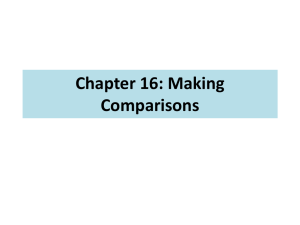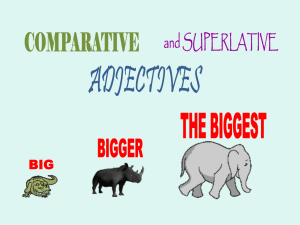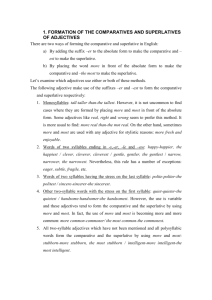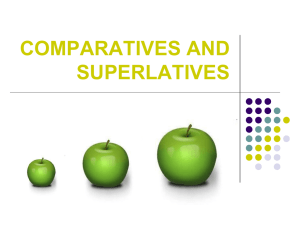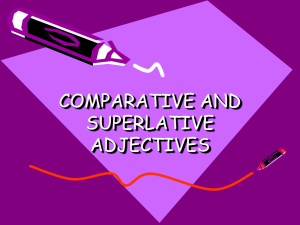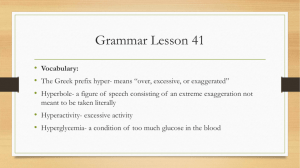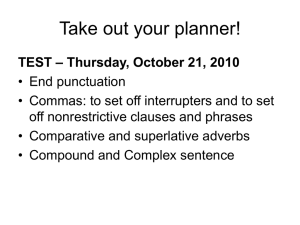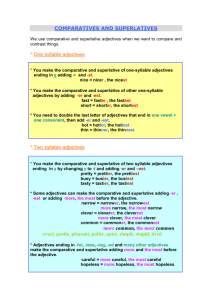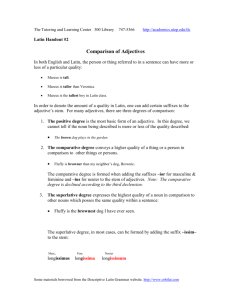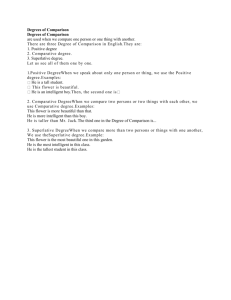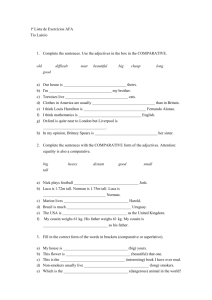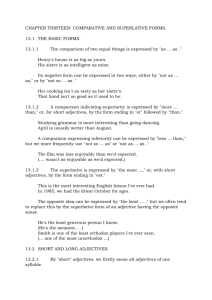information chapter 5
advertisement
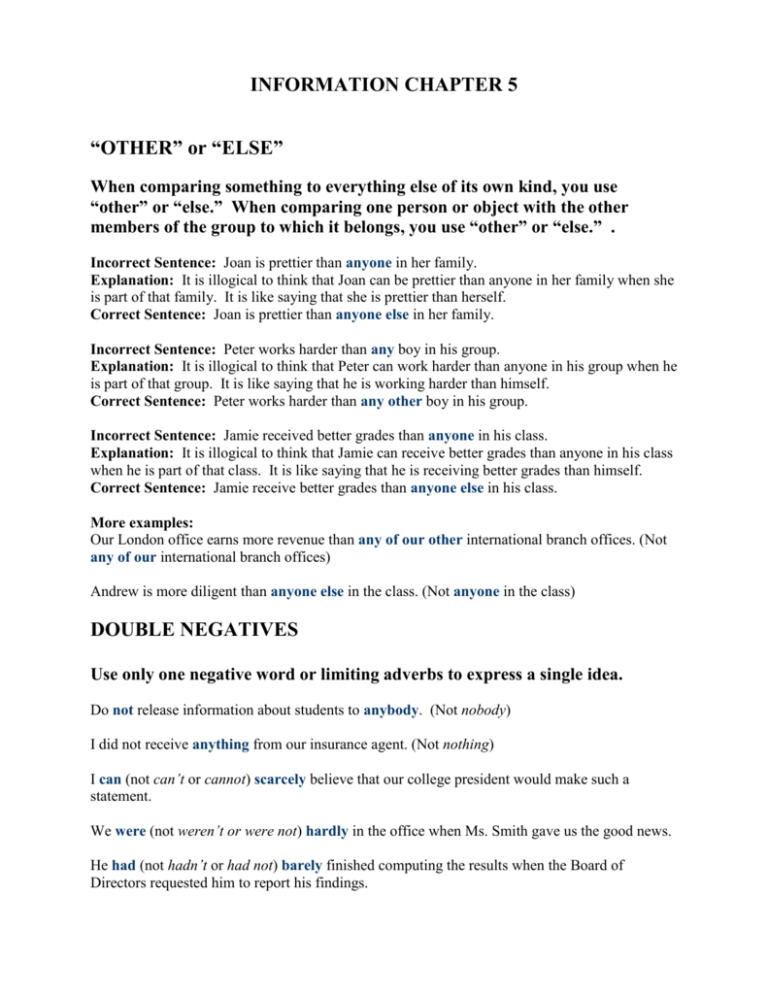
INFORMATION CHAPTER 5 “OTHER” or “ELSE” When comparing something to everything else of its own kind, you use “other” or “else.” When comparing one person or object with the other members of the group to which it belongs, you use “other” or “else.” . Incorrect Sentence: Joan is prettier than anyone in her family. Explanation: It is illogical to think that Joan can be prettier than anyone in her family when she is part of that family. It is like saying that she is prettier than herself. Correct Sentence: Joan is prettier than anyone else in her family. Incorrect Sentence: Peter works harder than any boy in his group. Explanation: It is illogical to think that Peter can work harder than anyone in his group when he is part of that group. It is like saying that he is working harder than himself. Correct Sentence: Peter works harder than any other boy in his group. Incorrect Sentence: Jamie received better grades than anyone in his class. Explanation: It is illogical to think that Jamie can receive better grades than anyone in his class when he is part of that class. It is like saying that he is receiving better grades than himself. Correct Sentence: Jamie receive better grades than anyone else in his class. More examples: Our London office earns more revenue than any of our other international branch offices. (Not any of our international branch offices) Andrew is more diligent than anyone else in the class. (Not anyone in the class) DOUBLE NEGATIVES Use only one negative word or limiting adverbs to express a single idea. Do not release information about students to anybody. (Not nobody) I did not receive anything from our insurance agent. (Not nothing) I can (not can’t or cannot) scarcely believe that our college president would make such a statement. We were (not weren’t or were not) hardly in the office when Ms. Smith gave us the good news. He had (not hadn’t or had not) barely finished computing the results when the Board of Directors requested him to report his findings. ADJECTIVE COMPARISON 1. Adjectives may be used to compare two or more nouns or pronouns. a. COMPARATIVE form (-“er” or more, less) to compare 2 persons or things b. SUPERLATIVE form (-“est” or most, least) to compare 3 or more persons or things 2. Most one-syllable adjectives ending in e add r for the comparative and “st” for the superlative. SIMPLE COMPARATIVE SUPERLATIVE nice nicer nicest fine finer finest tame tamer tamest large larger largest 3. Most one-syllable adjectives ending in consonants add “er” for the comparative and “est” for the superlative, but some double the final consonant before adding “er” or “est.” a. Some one-syllable adjectives ending in a consonant SIMPLE COMPARATIVE SUPERLATIVE short shorter shortest sweet sweeter sweetest mild milder mildest proud prouder prouder b. Some one-syllable adjectives ending in a consonant—double the consonant SIMPLE COMPARATIVE SUPERLATIVE big bigger biggest sad sadder saddest trim trimmer trimmest drab drabber drabbest 4. Most two-syllable adjectives and all adjectives containing three or more syllabus use more or less and most and least to construct comparative and superlative forms. Forms for those twosyllable adjectives that do not follow this pattern are shown in the dictionary after their simple form. These words include costly, friendly, happy, healthy, kindly, merry, lovely, pretty—all ending in y. a. Two-syllable adjective with more, most, less, or least SIMPLE COMPARATIVE SUPERLATIVE superb more superb most superb useful more useful most useful suitable more suitable most suitable b. Three-syllable adjective with more, most, less, or least SIMPLE COMPARATIVE SUPERLATIVE comprehensive more comprehensive most comprehensive practical more practical most practical expensive more expensive most expensive c. Two-syllable adjective using “er” or “est” SIMPLE COMPARATIVE SUPERLATIVE costly costlier costliest lonely lonelier loneliest heavy heavier heaviest 5. Irregular forms for adjective comparisons appear in the dictionary. They are listed after the simple forms. A list of commonly used irregular adjective forms follows: SIMPLE COMPARATIVE SUPERLATIVE bad, ill worse worst good, well better best far farther, further farthest, furthest little littler, less littlest, least many, much more most 6. Some adjectives cannot be compared in the regular sense because they are absolute. A partial list of such adjectives follows: alive, finished, round complete, full, straight, dead, perfect, unique 7. Absolute adjectives may show comparison by use of the forms “more nearly” or “most nearly.” SIMPLE COMPARATIVE SUPERLATIVE full more nearly full (not fuller) most nearly full (not fullest) accurate more nearly accurate (not more accurate) most nearly accurate (not most accurate) ADVERB COMPARISON 1. One-syllable adverbs and some two-syllable adverbs are compared by adding “er” or “est.” For comparisons between two items, use “er”; for comparisons among more than two items, use “est.” a. Comparison of two i. You live closer to the library than I.. ii. My assistant left earlier than I. b. Comparison of more than two i. Of all the students in the study group, you live the closest to the library. ii. Who is scheduled to arrive the earliest—Bill, Paula, or Bob? 2. Most adverbs containing two syllables and all adverbs containing more than two syllables from the comparison by adding more or most (or less or least) to the positive form. Use more (or less) in comparing two items and most (or least) in comparing more than two items. a. Comparisons of two i. This conveyer belt travels more slowly than the one next to it. ii. Please pack these items more carefully than you have done in the past. iii. Surf soap is less widely used on the East Coast than in the South. b. Comparisons of more than two i. Denver has been mentioned most often as the likely site for our next convention. ii. This conference is the most unusually conducted one I have ever attended. iii. This brand of soap is the least widely used of all the major brands.
